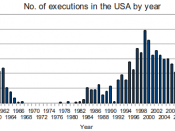For the past several months Americans have regularly listed crime and violence as the number - one problem facing the nation, far surpassing worries over the economy or health care.
Despite the many government and community initiatives launched during recent years to reduce crime, most Americans see no improvement. In a 1993 survey asking respondents if they felt crime was increasing or decreasing in their areas, only 5 % felt that it was decreasing, a full 93 % felt that crime was either increasing or staying the same. And it is not just statistics: I consider myself along with those 93 %. Because while Guiliani administration is talking about crime rates in the New York City going down, all I see and hear in the media are reports about horrible crimes committed by New Yorkers.
As George Pettinico states in his article ' Crime and punishment: America changes it's mind ': The media's extensive coverage of crime, especially the most brutal and horrific cases have heightened the public's fear and anger over this issue to a near frenzy.
When asked in January of this year, ' How often do you see reports of violent crime on television ? ' 68 % replied ' almost every day '.
Although the media have played an important role in raising the public's awareness of lawlessness, crime in America is far from a media - created phenomenon. Government statistics support the image of a nation which has overwhelmingly lost the war against crime. For instance, in 1960 there were 161 reported violent crimes per 100,000 people By 1992, the figure had jumped to 758 per 100,000 -- a rise of over 350 %.
More and more people today are starting to think that something is terribly wrong when a modern, civilized nation must confront...



Good Authorities
This essay did a good job of selecting authorities and weaving them skillfully into the paper. The token mention of the Bible seemed weak, I'd throw that out. Bibliography!
0 out of 0 people found this comment useful.